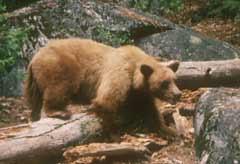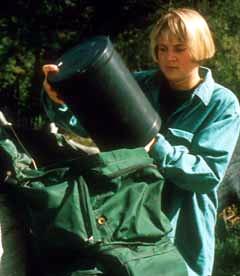
American black bears (Ursus americanus) are an integral part of the Sierra Nevada ecosystem. Most Sierra Nevada bears are not black in color. They are usually some shade of brown, ranging from almost blond, to reddish brown, to a dark chocolate color.
They are protected in the National Parks but hunting is allowed outside of the parks. There are an estimated 20,000 to 24,000 black bears in California, despite a fall hunting season that annually removes up to 1,500 bears from the population.
A common question is how big are Sierra Nevada bears? This is a difficult question to answer because bears, like people, can vary greatly in size. Also, an individual bear's weight can change greatly throughout the year. Before entering winter hibernation, a bear's weight can be double what it was when it emerged from its den the previous spring.
In general, the weight of an average, adult male black bear in summer is 300 to 350 pounds. Females are smaller, with typical weights ranging from 200 to 250 pounds. Much bigger bears, however, do occur. The largest black bear ever captured in Yosemite National Park weighed 690 pounds!
Black bears forage on a wide variety of natural foods, including grasses, insects, berries, and acorns. The bears, however, are intelligent and adaptable, and will readily accept human foods when they are available.
Bears that are exposed to human food often change their behavior and begin seeking it in campgrounds, parking lots, and from backpackers. This results in property damage and dangerous confrontations between humans and bears. The ecological role of such bears is also changed - their use of natural foods diminishes, they become more nocturnal, and the elevation range of habitat use changes.

When a bear's search for human food makes them aggressive toward humans, it poses an unacceptably high threat and they must be killed. As a result, black bears have been the subject of intense management efforts in the Sierra Nevada for many years, to protect both people and the bears.
Black bears that have not become accustomed to humans are generally shy and usually avoid humans; with their keen hearing and good sense of smell, they're usually aware of us before we're aware of them. They can be scared away by loud noises. Unfortunately, in most areas of the Sierra Nevada, bears ignor attempts to chase them away.
You are required by law to protect your food from bears. Storage lockers are provided in some locations and the use of bear cannisters by backpackers is required in some areas. It is important for you to check with the managment agency regarding the rules where you plan to hike. Click here for more information about bears and bear cannisters.
PREVENTING BEAR PROBLEMS
Bears are opportunistic and will search for human food supplies when natural foods are not available. Maintaining a sustainable bear population depends on minimizing human-bear conflicts. The majority of conflicts can be avoided. Here are some tips on preventing bear problems.
Remember: A fed bear is a dead bear!
When black bears are fed, they quickly learn unbearlike behaviors. Sadly, this may lead to serious, often deadly, results for the bear. You can prevent this by following the simple guidelines above.